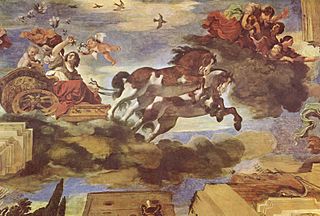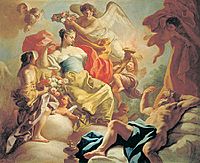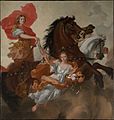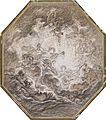Aurora (mythology) facts for kids
- The phenomena that can be seen in the atmosphere is at Aurora

Aurora was the ancient Roman equivalent of Eos. Eos was the ancient Greek goddess of the dawn. Aurora is the Latin word for dawn.
Aurora renews herself every morning at dawn and flies across the sky. She announces the morning's arrival. She has a brother and a sister. Her brother is the sun, and her sister is the moon. She also has many husbands and four sons, one for each cardinal direction: North, East, South, and West.
Aurora is comparable to Eos in Greek mythology and to Ushas in Hindu mythology.
One of her lovers was Tithonus. Aurora asked Zeus to grant immortality to Tithonus. However, she failed to ask him for eternal youth. As a result, Tithonus ended up aging eternally.
In Shakespeare's Romeo and Juliet (i.i) Montague says of his lovesick son Romeo
- But all so soon as the all-cheering sun
- Should in the farthest east begin to draw
- The shady curtains from Aurora's bed,
- Away from the light steals home my heavy son...
In the poem "Tithonus" by Lord Alfred Tennyson, Aurora is described as folllows:
- Once more the old mysterious glimmer steals
- From thy pure brows, and from thy shoulders pure,
- And bosom beating with a heart renewed.
- Thy cheek begins to redden through the gloom,
- Thy sweet eyes brighten slowly close to mine,
- Ere yet they blind the stars, and the wild team
- Which love thee, yearning for thy yoke, arise,
- And shake the darkness from their loosened manes,
- And beat the twilight into flakes of fire.
The asteroid 94 Aurora was named after her.
Images for kids
-
Aurōra Heralding the Arrival of the Morning Sun, c. 1765, by François Boucher
See also
 In Spanish: Aurora (mitología) para niños
In Spanish: Aurora (mitología) para niños




